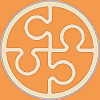Reg: Judean People's Front! We're the People's Front of Judea! Judean People's Front! Cuh!
...
Reg: Right. You're in. Listen. The only people we hate more than the Romans are the fucking Judean People's Front.
Stan: Yeah, the Judean People's Front.
Reg: Yeah. Splitters.
Stan: And the Popular Front of Judea.
Reg: Yeah. Splitters.
Stan: And the People's Front of Judea.
Reg: Yea... what?
Stan: The People's Front of Judea. Splitters.
Reg: We're the People's Front of Judea!
Stan: Oh. I thought we were the Popular Front.
Reg: People's Front!
Francis: Whatever happened to the Popular Front, Reg?
Reg: He's over there. [points to a lone man]
What's wrong with this sketch as an illustration of Liberal Catholicism is that people don't hate one another at all; what is right about it is the myriad of small groups and variations and a history of wanderings.
The fact that these groups are small means that they change quickly. People leave and people join. The characteristics of the groups then should be understood according to the histories of them as they have evolved.
 Back in January 2008 the Revd. Deaconess Pam Schroder, in charge of the Ancient Catholic Church, died. Coming then under the wing of the leadership of The Liberal Rite, it and the Ancient Catholic Church ran in parallel. The Ancient Catholic Church was pretty much the creation of H. P. Nicholson, who, from the 1950s, developed a Liberal Catholic Church of (at its peak) a number of congregations that had Catholic, spiritualist and animal ministry characteristics. Its last actual church building, the Cathedral Church of the Good Shepherd, always for the use of the Deaconess, ceased its tenancy and role with her death.
Back in January 2008 the Revd. Deaconess Pam Schroder, in charge of the Ancient Catholic Church, died. Coming then under the wing of the leadership of The Liberal Rite, it and the Ancient Catholic Church ran in parallel. The Ancient Catholic Church was pretty much the creation of H. P. Nicholson, who, from the 1950s, developed a Liberal Catholic Church of (at its peak) a number of congregations that had Catholic, spiritualist and animal ministry characteristics. Its last actual church building, the Cathedral Church of the Good Shepherd, always for the use of the Deaconess, ceased its tenancy and role with her death.What I liked about the Liberal Rite was not so much its apostolic succession and that side, though obviously that gave it its Catholic characteristic, but its identification with various origins, both Trinitarian in Liberal Catholicism (with Theosophy) and Unitarian, and, with the Ancient Catholic Church, I also warmed to the outreach I could read about with H. P. Nicholson, though I am less interested in the spiritualist side (but talking to a spiritualist recently, so there you go).
The Ancient Catholic Church and the Liberal Rite have both attracted some interest even within one year and have grown: both have, along with the Independent Liberal Catholic Fellowship. It is clearly well organised, along with associated educational functions and the semi-attached humanistic side - The Society for Humanistic Potential (a reflection of some Unitarian origins and personality there too).
Well the People's Front of Judea and the Popular Front of Judea have merged. The Liberal Rite and the Ancient Catholic Church are no more. Now we have The Liberal Catholic Apostolic Church instead, combining both inheritances.
From the Ancient Catholic Church side comes the Bishop Nicholson Creed:
We believe in God; the Father the Source of life, the Son the Revelator of love, the Holy Spirit the best Owner of power; we believe in the Fatherhood of God, the brotherhood of Man, in the gifts of the Spirit, in the immortality of the soul, and in everlasting life. Amen.
It is a minimalist creed and alongside an anti-doctrinal approach, but it also consists of continuations with, now, Gnosticism, Theosophy and Christian Spiritualism.
I suppose, to be honest, and perhaps because I am an associate of the Judean People's Front, that my more rational side has some difficulties here. Nevertheless I am pleased to see that, via this route, Alistair Bate comes on board, that there is a church in Portland, the United States, and it has the various associated organised bodies - a sort of integration.
In mid-February 2008 there were no plans to merge, so it shows how speedily these bodies can change. The decision to merge is given here. Reflections from Portland are here and here. There is also the Independent Liberal Catholic Fellowship that gathers clergy and communities across the Liberal Catholic tradition.



2 comments:
Yes, there are many branches in the LCC movement.
Liberal Catholich Church International and split in 2007: Universal Catholic Church.
Liberal Catholic Church Old and New Synod
LCC Theosophy Synod
LCC Grail Community
Reformed LCC
Young Rite
And now LCAC
It is very interesting!
Except in this case the remnant and then expansion of the Ancient Catholic Church was merged with the Liberal Rite.
This merger is like a couple of distinctive bags put into another bag. I'm unsure if these are shades of the same colours, complementary colours or what, though what matters is how they are being led and how they now develop. There is a difference between the warmth of the esoteric/ spiritualist and the cooler liberal inheritance that carries the more rational end. This seems to be a shift in the warmer more esoteric direction, and the more credal even (in that direction).
Post a Comment